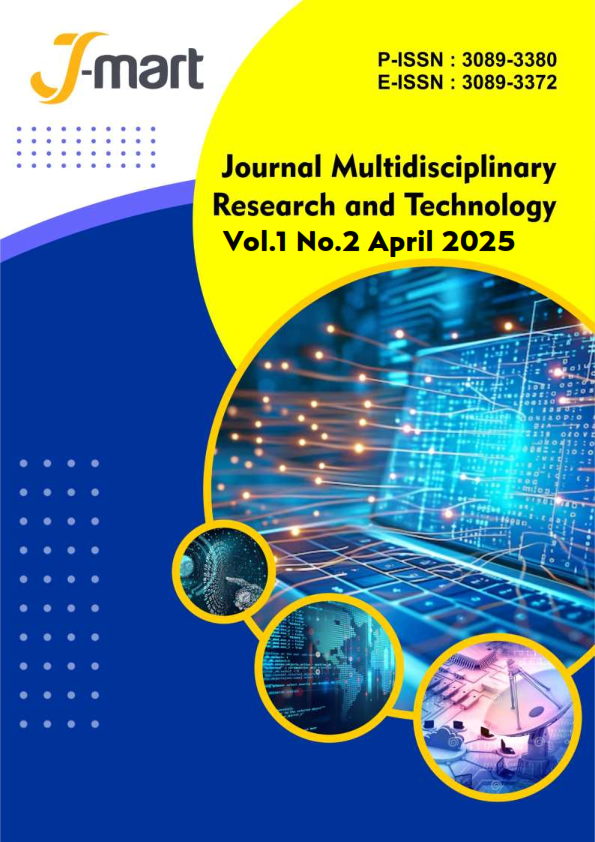Peltier Power Effect Monitoring as Electrical Energy Generation
DOI:
https://doi.org/10.63891/j-mart.v1i2.60Keywords:
sumber energi, pembangkit, peltier, ramah lingkunganAbstract
Climate change and the depletion of fossil energy resources have driven the search for alternative energy sources that are more environmentally friendly and sustainable. One promising solution is the development of renewable energy systems that optimally utilize natural resources. Thermogeneration technology, which converts temperature differences into electrical energy, has become a focal point in the advancement of renewable energy. The Peltier module, as the core component of this technology, is capable of generating electrical voltage through the thermoelectric effect caused by a temperature difference between its two sides In this study, the Peltier module is used to generate electricity from industrial waste heat or other ambient heat sources. The objective of this research is to identify the energy conversion efficiency and the practical limitations of the Peltier module in renewable energy systems. By employing a device designed to convert heat energy into electrical energy, while also monitoring temperature and voltage, the study evaluates the performance of the Peltier module and introduces a testing methodology to measure the relationship between temperature and voltage. Test results indicate a linear relationship between temperature and generated voltage, with a slope of 0.0375 V/°C, suggesting that the greater the temperature difference, the higher the voltage produced. This research is expected to contribute to the development of Peltier-based renewable energy technologies and to improve the efficiency of waste heat utilization in supporting more environmentally sustainable energy practices.
References
Mirmanto, Syahrul dan Wirawan, M. (2021). Teori Dasar dan Aplikasi Pendingin Termoelektrik (Pendingin Tanpa Freon). Sleman: Deepublish
Patil, dkk. (2017). "Thermoelectric Refrigeration Using Peltier Effect" (PDF). International Journal of Engineering Sciences & Research Technology.
Mani, P. I. (2016). Design , Modeling and Simulation of a Thermoelectric Cooling System ( TEC ).
Fikri, Hafidh Abdurrohman Al and , Ir. Abdul Basith, MT (2016). Efektifitas Modul Peltier TEC-12706 Sebagai Generator Dengan Memanfaatkan Eenergi Panas Dari Modul Peltier TEC-12706. Skripsi thesis, Universitas Muhammadiyah Surakarta.
Chen, W., & Liu, K. (2022). IoT-based automatic fire alarm system. International Journal of Internet of Things, 11(3), 56–62. https://doi.org/10.1016/ijit.2022.11056
Zhen, Y., & Hu, R. (2024). IoT-based smart fire alarm systems for residential and commercial buildings. Smart Safety Systems, 10(1), 34–41. https://doi.org/10.54321/sss.v10i1.0034
Tan, K., & Lim, H. (2023). Development of IoT-based systems for mushroom cultivation. Agricultural IoT Journal, 8(5), 145–152. https://doi.org/10.43210/aij.v8i5.0145
Wang, X., & Luo, J. (2023). Smart mushroom cultivation with IoT integration. Journal of Agricultural Innovation, 16(2), 78–85. https://doi.org/10.09876/jai.v16i2.0078
Gomez, J. R., & Perez, L. (2023). Design and implementation of SensePack: An IoT-based mushroom cultivation monitoring system. Computers and Agriculture, 15(5), 432–440. https://doi.org/10.56789/compag.v15i5.0432
Hossain, T., & Rahman, F. (2024). IoT-based fire alarm security system with real-time notifications. Journal of Smart Technologies, 22(1), 88–95.https://doi.org/10.1109/jst.220188
Downloads
Published
Issue
Section
License
Copyright (c) 2025 Journal Multidisciplinary research and technology

This work is licensed under a Creative Commons Attribution-ShareAlike 4.0 International License.





